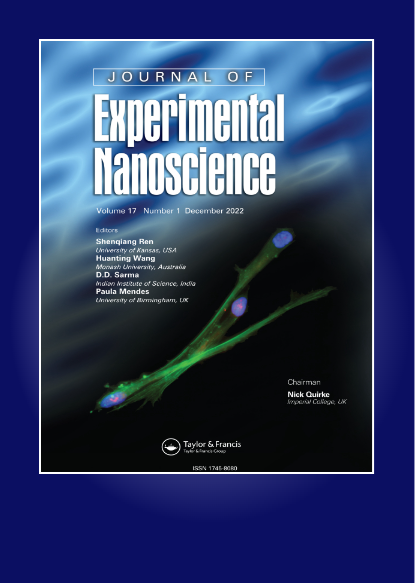用于图像引导神经胶质瘤纳米治疗的吲哚菁绿色负载外泌体
IF 2.6
4区 材料科学
Q2 CHEMISTRY, MULTIDISCIPLINARY
引用次数: 3
摘要
多形性胶质母细胞瘤(Glioblastoma multiforme, GBM)是最具侵袭性和致死率的脑肿瘤类型,是近红外荧光染料检测到的最具侵袭性和致死率的脑肿瘤类型,但难以直接靶向脑肿瘤。因此,我们的研究旨在开发一种新的ICG载体,以便在手术中准确地显示癌组织。从培养的U-87 MG细胞中分离外泌体,然后负载吲哚菁绿(ICG)并结合RGERPPR肽(RGE) (R-exo-ICG)。分析R-exo-ICG的各项参数,并将其注射到荷瘤裸鼠体内,评价其抗肿瘤作用。R-exo-ICGs为纳米级,在24 h内完全释放ICG。激光照射后,RGE修饰增加了外泌体的细胞摄取,通过激活Caspase 3信号通路诱导细胞凋亡。此外,R-exo-ICG在体内大量积累在脑肿瘤中,抑制荷瘤小鼠的肿瘤生长。rge结合的外泌体装载ICG可以靶向小鼠脑肿瘤,并显著抑制小鼠肿瘤生长,这表明R-exo-ICG可能是治疗GBM的一种新方法。本文章由计算机程序翻译,如有差异,请以英文原文为准。
Indocyanine green-loaded exosomes for image-guided glioma nano-therapy
Abstract Glioblastoma multiforme (GBM) is the most aggressive and deadliest type of brain tumor with a > >th he most aggressive and deadliest type of brain tumor witnear-infrared fluorescent dye, but it is hard to directly target brain tumor. Therefore, our study aimed to develop a new carrier for ICG to accurately visualize cancer tissue during surgery. Exosomes were isolated from culture U-87 MG cells, then loaded with Indocyanine green (ICG) and conjugated with RGERPPR peptide (RGE) (R-exo-ICG). The parameters of R-exo-ICG were analyzed and injected into tumor-bearing nude mice to evaluate its anti-tumor effect. R-exo-ICGs were nano size, and completely released ICG within 24 h. RGE modification increased cell uptake of exosomes, and induced cell apoptosis through activating Caspase 3 signaling pathway after laser irradiation. Moreover, R-exo-ICG was largely accumulated in the brain tumor in vivo, and inhibited tumor growth in tumor-bearing mice. RGE-conjugated exosomes that loaded ICG could target brain tumor in mice and significantly inhibited tumor growth in mice, which suggested that R-exo-ICG might serve as a novel approach for GBM treatment.
求助全文
通过发布文献求助,成功后即可免费获取论文全文。
去求助
来源期刊

Journal of Experimental Nanoscience
工程技术-材料科学:综合
CiteScore
4.10
自引率
25.00%
发文量
39
审稿时长
6.5 months
期刊介绍:
Journal of Experimental Nanoscience, an international and multidisciplinary journal, provides a showcase for advances in the experimental sciences underlying nanotechnology and nanomaterials.
The journal exists to bring together the most significant papers making original contributions to nanoscience in a range of fields including biology and biochemistry, physics, chemistry, chemical, electrical and mechanical engineering, materials, pharmaceuticals and medicine. The aim is to provide a forum in which cross fertilization between application areas, methodologies, disciplines, as well as academic and industrial researchers can take place and new developments can be encouraged.
 求助内容:
求助内容: 应助结果提醒方式:
应助结果提醒方式:


